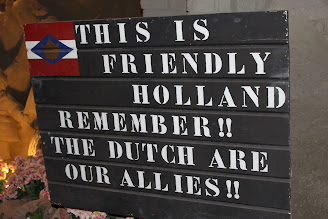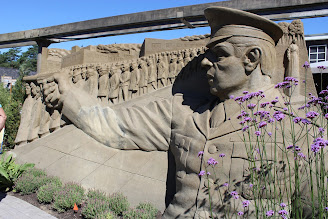This year's Sand Sculptures had 75 years of Liberation as its theme. Like last year it was all brilliantly done. Unlike last year, the artists who actually made the sculptures were named on a large wall. They came from the Netherlands, Russia, Ukraine, Poland, Bulgaria, UK, Ireland, USA, Germany, Belgium and Italy.
As I said, the theme was 75 years of the Netherlands being liberated from the German oppressor. And just to make sure our allies knew we weren't the German enemy, these signs appeared. This one most likely done by the Canadian army. It was them and the British army that liberated most of the Netherlands. The Americans had turned right to catch Hitler(!).
The Germans had wanted several things, one of them church bells to turn into weaponry. Some of the bells were hidden and/or buried, others were taken away by the oppressor. And on some of those was written in chalk: Those who fight with God's Bells, will not win the war! Some churches did get their bells back after the war, unused, others had to get new ones.
The little village of Putten was hit extremely hard during the war. After a sabotage action by the resistance which resulted in the death of one resistance fighter and one German officer, several others being severely wounded, the Germans retaliated by setting fire to over 100 houses and capturing over 600 men and boys. In the end only 48 returned from Germany. Read more here.
Probably the most famous of all Jewish children that were killed during the war was Anne Frank. She lived the normal life of a teenage girl at the time. But she wasn't the only one: thousands of other babies, toddlers, children and teenagers lost their lives.
This was one of two large scenes, depicting Operation Market Garden. Had it worked it would have cut the war short for the Netherlands. Unfortunately it didn't and although some areas were free, other areas suffered another winter under German occupation. Hardly any food and hardly any fuel resulted in famine and hunger marches.
On the other side was another big scene that would eventually bring the Americans into play: the Japanese attack on Pearl Harbour. That attack meant the Americans were now also at war with Germany as they declared war on the USA as well (Japan being their ally). The war in the East also meant that once Germany was defeated, the Netherlands was still in a war situation as the Dutch Indies (Indonesia now) was still occupied by the Japanese. That didn't end until August 1945.
One piece of equipment used by the Germans in the war had a very Dutch connection. Its origins were Dutch, but then there were squabbles over the copyright and such and it ended up in German hands. They continued on the theme and it wasn't until Alan Turing and his colleagues understood it that the Enigma machine was crackable.
The most important painting in the Netherlands is probably the Night Watch by Rembrandt. So, it had to be used. Just a bit differently this time though. I especially love the dog in this version.










Hari OM
ReplyDeleteAb Fab, Mara!!! I adore this artform and the theme for this is poignant. Thank you for making the visit on our behalf! YAM xx
The theme was very fitting. I just felt they missed out on the war in the East. So many (Dutch) people suffered in the Japanese labour camps as well, but apart from one small display about the atom bomb, there was nothing else. A missed opportunity. But all in all a great day.
DeleteI can't believe how beautiful these are. They are spectacular! Those are very talented people. I'm so glad you got to go.
ReplyDeleteThe detail is so very amazing!
ReplyDeleteSuch beautiful sculptures. We can't wait to see more.
ReplyDeleteOH MY WORD these are gorgeous. I hope and pray there are not any rain storms, or perhaps is there something the treat them with to make them temporarily water proof.
ReplyDeletehugs cecilia
My FiL had a painting done by the Underground. I think it was Dutch. It went to another part of the family, not related by blood. Pity.
ReplyDeleteSo amazing that these figures are done with sand. During the spring I read a book about a small fictional island off the Dutch coast invaded by the Germans. Fascinating read. Shame I cannot remember the name. But I was only able to sit and was reading a book every day or two.
ReplyDeleteI can't seem to find any reference to that book at all. The only thing that keeps popping up is 'the Literary and Potato Peel Society', which deals with the invasion of the Channel Islands (most notably Guernsey in this book), which are part of the United Kingdom.
DeleteWhen you do find out what the title was again, please let me know...